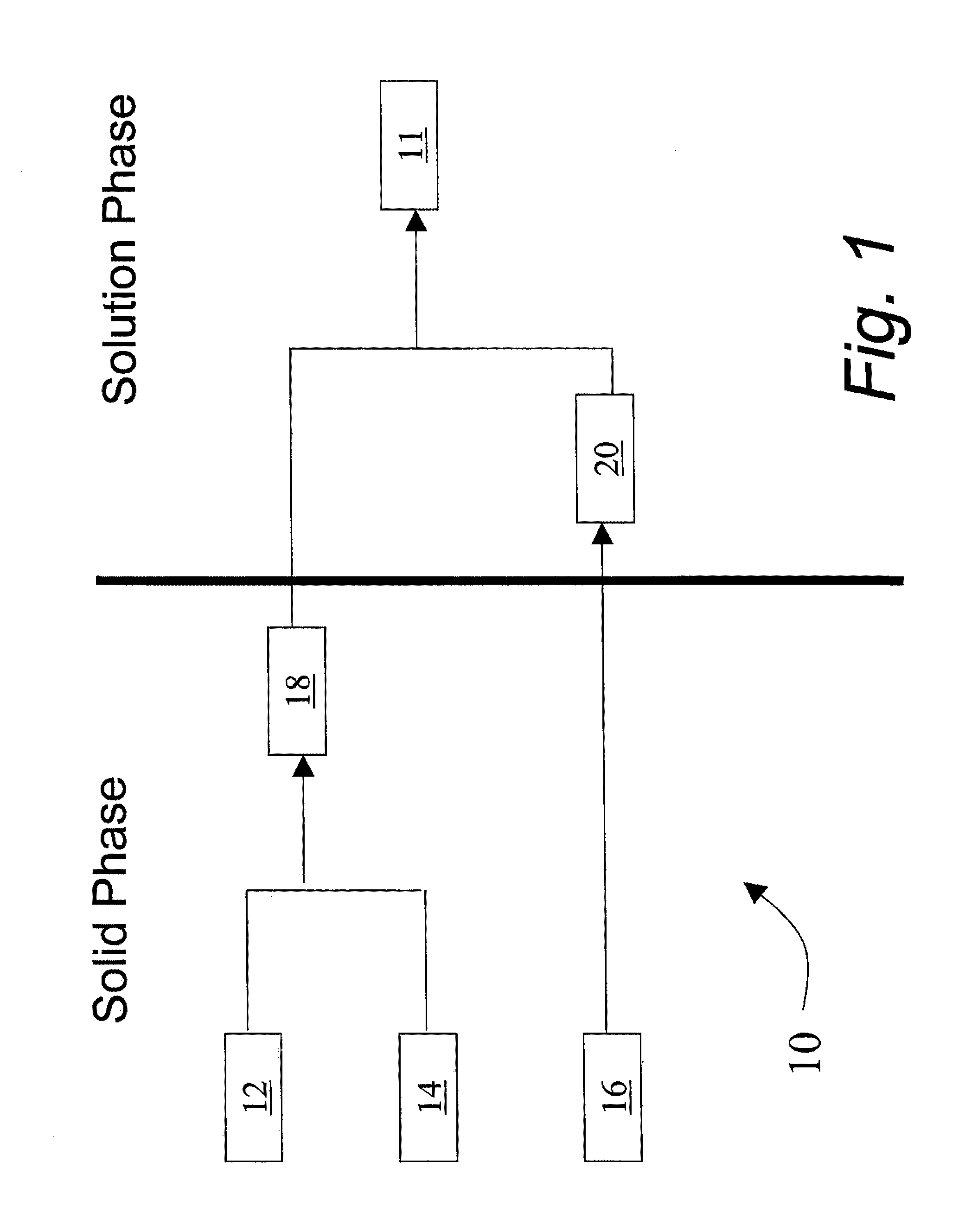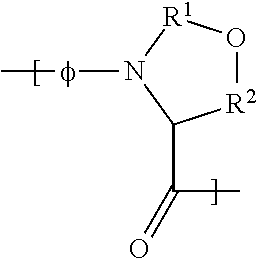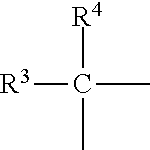Insulinotropic peptide synthesis using solid and solution phase combination techniques
a technology of solid phase and solution phase, which is applied in the field of preparing insulinotropic peptides, can solve the problems of affecting the efficiency of process steps such as coupling and deprotection, affecting the synthesis of peptide fragments, and affecting the synthesis of peptides. , to achieve the effect of easing the solid phase synthesis of the fragment and facilitating the subsequent solution phase coupling
- Summary
- Abstract
- Description
- Claims
- Application Information
AI Technical Summary
Benefits of technology
Problems solved by technology
Method used
Image
Examples
example 1
Solid Phase Synthesis of Fragment 12 with Fmoc Protection at the N-terminus, and Side Chain Protection on the His and Glu
A. Preparation of Fmoc-Gly-loaded 2CTC Resin
[0115]Initially, Fmoc-Gly-loaded 2CTC resin was prepared. Amounts of reagents used are listed in following table:
Preparation of Fmoc-Gly-2-Chlorotrityl ResinMaterialsMWEqmmolegramsmL2-Chlorotritylchloride resin——52.2435.06—Fmoc-Gly-OH297.3 1.0 13.063.88—Diisopropylethylamine129.252.3530.723.97(DIEA)Dimethyl formamide (DMF)1270Dichloromethane (DCM)17859:1 by volume 350Methanol:DIEAIsopropanol (IPA)1050
[0116]2-CTC resin was charged to a 500 mL peptide reactor and swelled with 400 mL DCM for 30 min at 25° C. The bed was drained and a solution of Fmoc-Gly-OH and DIEA in 8 volume of DMF:DCM (87.5:12.5) was added. The mixture was stirred under nitrogen for 2 hours at a temperature of 25° C.
[0117]The bed was drained and washed once with 350 mL DMF and once with 175 mL DMF. Then, remaining active sites on the 2-CTC resin were en...
example 2
A. Preparation of Fmoc-Gly-Loaded 2CTC Resin
[0125]Fmoc-Gly-loaded 2CTC resin was prepared. The amounts of reagents used are listed in following table:
Preparation of Fmoc-Gly-2-Chlorotrityl ResinMaterialsMWEqmmolegramsmL2-Chlorotritylchloride resin——59.6640.04—Fmoc-Gly-OH297.3 1.0 29.848.87—Diisopropylethylamine129.251.6749.906.45(DIEA)Dimethyl formamide (DMF)1580Dichloromethane (DCM)18409:1 Methanol:DIEA 390Isopropanol (IPA)1050
[0126]2-CTC resin was charged to a 500-mL peptide reactor and swelled with 400 mL DCM for 30 min. The resin was drained, and a solution Fmoc-Gly-OH and DIEA in 8 volume of DMF:DCM (87.5:12.5 by volume) was added. The mixture was stirred under nitrogen for 2 hours at a temperature of 25° C.
[0127]The resin bed was drained and washed once with 400 mL DMF and once with 200 mL DMF. Then, remaining active sites on the 2-CTC resin were end-capped with 390 mL of MeOH:DIEA (9:1 by volume) solution for 1 hour. The bed was drained again, washed two times with 350 mL DMF...
example 3
A. Preparation of Fmoc-Gly-Loaded 2CTC Resin
[0133]Fmoc-Gly-loaded 2CTC resin was prepared. The amounts of reagents used are listed in following table:
Preparation of Fmoc-Gly-2-Chlorotrityl ResinMaterialsMWEqmmolegramsmL2-Chlorotritylchloride resin——60.8840.86—Fmoc-Gly-OH297.3 1.0 42.5812.66—Diisopropylethylamine129.251.4863.218.17(DIEA)Dimethyl formamide (DMF)1380Dichloromethane (DCM)18409:1 Methanol:DIEA 390Isopropanol (IPA)1000
[0134]2-CTC resin was charged to a 500-mL peptide reactor and swelled with 400 mL DCM for 30 min. The bed was drained, and a solution Fmoc-Gly-OH and DIEA in 8 volume of DMF:DCM (87.5:12.5) was added. The mixture was stirred under nitrogen for 2 hours at a temperature of 25° C.
[0135]The bed was drained and washed once with 400 mL DMF. Then, any remaining active sites on the 2-CTC resin were end-capped with 390 mL of MeOH:DIEA (9:1) solution for 1 hour. The bed was drained, washed two times with 350 mL DMF, and then four times with 350 mL DCM. The resin was d...
PUM
| Property | Measurement | Unit |
|---|---|---|
| weight percent | aaaaa | aaaaa |
| weight percent | aaaaa | aaaaa |
| time | aaaaa | aaaaa |
Abstract
Description
Claims
Application Information
 Login to View More
Login to View More - R&D
- Intellectual Property
- Life Sciences
- Materials
- Tech Scout
- Unparalleled Data Quality
- Higher Quality Content
- 60% Fewer Hallucinations
Browse by: Latest US Patents, China's latest patents, Technical Efficacy Thesaurus, Application Domain, Technology Topic, Popular Technical Reports.
© 2025 PatSnap. All rights reserved.Legal|Privacy policy|Modern Slavery Act Transparency Statement|Sitemap|About US| Contact US: help@patsnap.com



